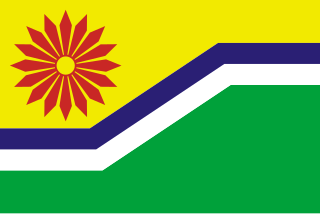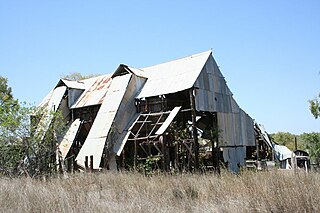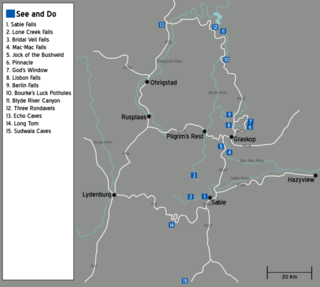
Placer mining is the mining of stream bed (alluvial) deposits for minerals. This may be done by open-pit or by various surface excavating equipment or tunneling equipment.

Mpumalanga is a province of South Africa. The name means "East", or literally "The Place Where the Sun Rises" in the Nguni languages. Mpumalanga lies in eastern South Africa, bordering Eswatini and Mozambique. It shares borders with the South African provinces of Limpopo to the north, Gauteng to the west, the Free State to the southwest, and KwaZulu-Natal to the south. The capital is Mbombela.

Hhohho is a region of Eswatini, located in the north western part of the country. Hhohho was named after the capital of King Mswati II, who expanded the Swazi territory to the north and west, taking in the districts of Barberton, Nelspruit, Carolina and Piet Retief. These areas were later acquired by what was the Province of Transvaal and today they form part of the Mpumalanga Province of South Africa. It has an area of 3,625.17 km², a population of 320,651 (2017), and is divided into 14 tinkhundla. The administrative center is the national capital of Mbabane. It borders Lubombo Region on the southeast and Manzini Region in the southwest.

The Witwatersrand Gold Rush was a gold rush that began in 1886 and led to the establishment of Johannesburg, South Africa. It was a part of the Mineral Revolution.
Barberton is a town in the Mpumalanga province of South Africa, which has its origin in the 1880s gold rush in the region. It is situated in the De Kaap Valley and is fringed by the Makhonjwa Mountains. It is 43 kilometres (27 mi) south of Mbombela and 360 kilometres (220 mi) east of Johannesburg.

Graskop is a small town in Mpumalanga province, South Africa. It was set up in the 1880s as a gold mining camp but it now serves as a tourist destination and the timber industry. “God’s Window”, a scenic view from the escarpment of the Lowveld below, is located outside the town. Graskop is 14 km south-east of Pilgrim's Rest and 28 km north of Sabie. It was laid out between 1880 and 1890 on a farm belonging to Abel Erasmus, Native Commissioner of the Transvaal Republic. The name is Afrikaans for grassy hillock. Originally it was a mining camp. It is the best place to view the "Edge of the Lowveld", with a sudden drop of 700 metres.

The Mineral Revolution is a term used by historians to refer to the rapid industrialisation and economic changes which occurred in South Africa from the 1860s onwards. The Mineral Revolution was largely driven by the need to create a permanent workforce to work in the mining industry, and saw South Africa transformed from a patchwork of agrarian states to a unified, industrial nation. In political terms, the Mineral Revolution had a significant impact on diplomacy and military affairs. Finally, the policies and events of the Mineral Revolution had an increasingly negative impact on race relations in South Africa, and formed the basis of the apartheid system, which dominated South African society for a century. The Mineral Revolution was caused by the discovery of diamonds in Kimberly in 1867 and also by the discovery of gold in Witwatersrand in 1886. The mineral mining revolution laid the foundations of racial segregation and the control of white South Africans over black South Africans. The Mineral Revolution changed South Africa from being an agricultural society to becoming the largest gold producing country in the world.

Hans Merensky was a South African geologist, prospector, scientist, conservationist and philanthropist.

Kaapschehoop or Kaapsehoop is a village situated in Mpumalanga province of South Africa.
Leechtown is at the confluence of the Leech River into the Sooke River in southern Vancouver Island, British Columbia. The ghost town, off BC Highway 1 is about 59 kilometres (37 mi) by road northwest of Victoria.

Robbers Pass is situated in the Mpumalanga province, on the R533 between Ohrigstad and Pilgrims Rest.

The Motlatse River, Blyde River, or Umdhlazi River is a river in the Mpumalanga and Limpopo provinces of South Africa. It has a northwards course in steep-sided valleys and ravines of the Mpumalanga Drakensberg, before it enters the lowveld region of the Limpopo province. It has its ultimate origins at around 2,000 m altitude in the Hartebeesvlakte conservation area, to the north of Long Tom Pass. It runs through the Blyde River Canyon.

Gardner Frederick Williams was an American mining engineer and author, and the first properly trained mining engineer to be appointed in South Africa.

The Transvaal gold fields resulted from gold discoveries during the 19th century in the South African Republic. After insignificant discoveries from 1840 up to 1870, payable or substantial gold deposits were found at:
Bakerville is a town in Ditsobotla Local Municipality in the North West province of South Africa.

Nuggety Gully Water Race and Chinese Camp is a heritage-listed mining camp at Mareeba Mining District, Lakeland, Shire of Cook, Queensland, Australia. It was built from c. 1878 to c. 1886. It is also known as Greasy Bill Creek water race, Prospect Creek Stone Walls, and Star of Normanby Mine. It was added to the Queensland Heritage Register on 21 October 1992.

Kidston State Battery is a heritage-listed stamper battery at Kidston in Einasleigh, Shire of Etheridge, Queensland, Australia. It was built from 1907 to 1950. It is also known as Kidston Township. It was added to the Queensland Heritage Register on 21 October 1992.

The Panorama Route is a scenic road in South Africa connecting several cultural and natural points of interest. The route, steeped in the history of South Africa, is in Mpumalanga province, centred around the Blyde River Canyon, the world's third largest canyon. It features numerous waterfalls, one of the largest afforested areas in South Africa, and several natural landmarks. The route starts at the foot of the Long Tom Pass just outside Lydenburg, following the natural descent from the Great Escarpment to the Lowveld, and ending at the border of the Mpumalanga and Limpopo provinces near the Echo Caves.
Stonewall Resources is an Australian gold mining company with exploration and development operations in New South Wales, Australia and Mpumalanga Province, South Africa.

Christiaan Hendrik Muller was a Boer general during the Anglo-Boer War (1899-1902). He succeeded General Ben Viljoen as the sole leader of the Boer forces in the Eastern Transvaal after Viljoen was captured by British troops on 25 January 1902 and sent to St. Helena as a prisoner of war.


























